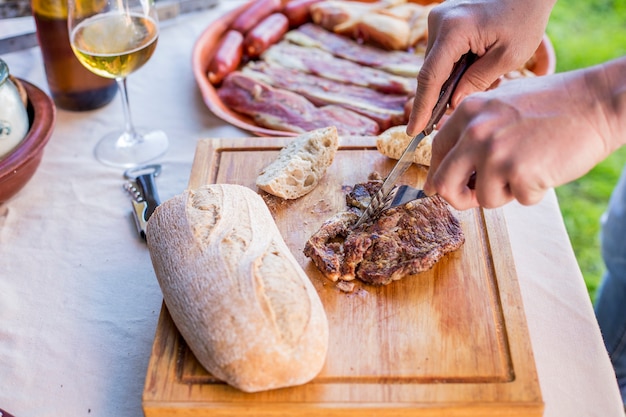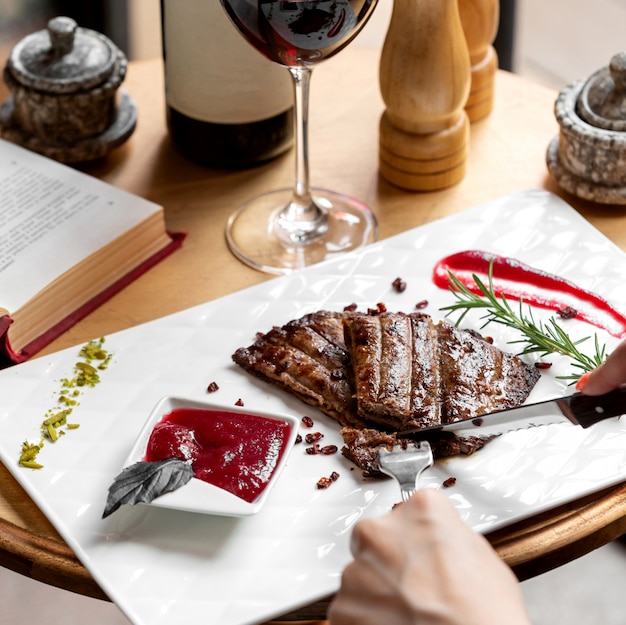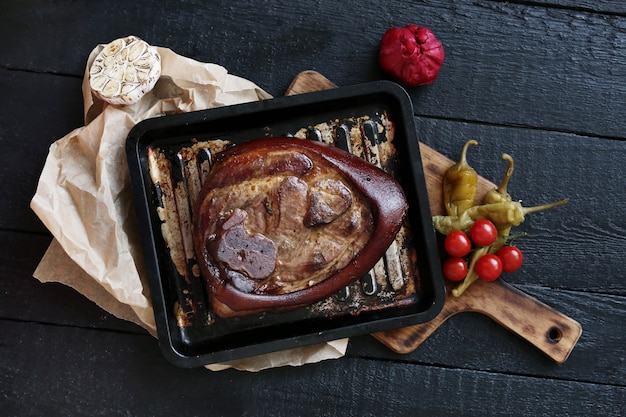Alright, let's talk venison! And not just any venison, but the crown jewel: the deer tenderloin. I've been a hunter for years, and there's nothing quite like the feeling of bringing home a prize buck, especially knowing that beautiful, lean tenderloin is waiting to be transformed into a delicious meal. But let's be honest, cooking venison can be a bit of a learning curve. It's not your standard supermarket steak, it's got its own personality. That's why I'm here, to share my tried-and-true tips, tricks, and favourite recipes, turning you into a venison cooking pro in no time!
(Part 1) Understanding the Deer Tenderloin: The Heart of the Hunt

Let's get acquainted with our star ingredient. The deer tenderloin, nestled along the backbone, is a long, cylindrical muscle known for its delicate flavour and oh-so-tender texture. Now, you won't find this cut at your local butcher's, you'll need to head to a game processor. They'll clean and trim it for you, usually giving you a couple of pieces, sometimes with that pesky silver skin still attached.
The Silver Skin: A Sneaky Little Film
So, what's the deal with that silver skin? It's a thin, tough membrane that can make your tenderloin chewy, a real party pooper! You've got to get rid of it. It's surprisingly easy to peel off, just grab it with a sharp knife and pull it away from the meat. You'll be left with a lovely, smooth surface, ready to be seasoned and transformed into something amazing.
Tenderloin vs. Backstrap: A Tale of Two Cuts
You might hear people talk about “backstrap,” which is actually the same muscle as the tenderloin but refers to a larger section including both the tenderloin and the sirloin. It's basically the “loin” of the deer. You're more likely to find the backstrap at your game processor, and it’s a great choice for grilling or roasting. But for this guide, we’re focusing on the tenderloin, that delicate, beautiful piece of meat.
(Part 2) Preparing the Deer Tenderloin: The Art of Tenderizing

Alright, time to get our hands dirty! First step: trim any excess fat. Remember, deer tenderloin is lean, so you won't find much fat, but any that's there needs to be trimmed. A sharp knife is your best friend here.
The Secret to tender venison: Don't Overdo It!
One of the biggest mistakes people make with venison is overcooking it. It can go from tender and juicy to dry and tough in a flash. My biggest tip? Don't be afraid to cook it rare or medium-rare. That's how I do it, and it's the best way to bring out its natural flavour. I know some people are a bit hesitant about rare venison, but it's perfectly safe as long as the meat reaches an internal temperature of at least 145 degrees Fahrenheit (63 degrees Celsius).
Marinating Your Tenderloin: A Flavour Symphony
Marinating is a great way to add flavour and tenderness to your venison. I prefer simple marinades, nothing too fancy. My go-to is a mix of olive oil, red wine vinegar, garlic, rosemary, salt, and pepper. Let the tenderloin soak in the marinade for at least 4 hours, or even overnight in the fridge. The longer, the better! The marinade will work its magic, tenderizing the meat and adding a beautiful depth of flavour.
Dry Brining: A Salt-Based Transformation
Dry brining is another fantastic technique that works wonders with venison. Simply rub the tenderloin with salt and a touch of sugar, then leave it uncovered in the fridge for at least 24 hours. The salt will draw out moisture, then reabsorb it, resulting in a more tender and juicy meat. It's a bit of a magical process, really.
(Part 3) cooking techniques for Deer Tenderloin: Exploring the Options

Now, let's dive into some cooking techniques. It's all about finding what works best for you and your taste buds.
1. Pan-Seared Deer Tenderloin: A Classic Approach
This is a classic method for cooking deer tenderloin, and it's incredibly easy. Heat a heavy-bottomed pan over medium-high heat and add a bit of oil. Sear the tenderloin for 2-3 minutes per side, then reduce the heat to medium and cook for another 5-7 minutes, or until it reaches your desired level of doneness.
My secret weapon? I like to add a knob of butter to the pan in the last few minutes of cooking. It creates a delicious sauce that you can drizzle over the tenderloin. You can also finish it off with a sprig of rosemary or thyme for an extra burst of flavour.
2. Grilled Deer Tenderloin: Summertime Perfection
Nothing beats a perfectly grilled tenderloin on a sunny day. Get your grill nice and hot, around 450-500 degrees Fahrenheit. Then, cook the tenderloin for 3-4 minutes per side, or until it reaches the desired level of doneness. Remember, it's a lean meat, so it'll cook pretty quickly.
I've learned that using a grill with good, even heat distribution is crucial for success. Keep an eye on the temperature, and don't overcook it! It's easy to get carried away, but patience is key.
3. Roasted Deer Tenderloin: A Hearty Feast
Roasting is a great option if you're cooking for a crowd. Preheat your oven to 375 degrees Fahrenheit, and place the tenderloin on a roasting rack over a baking sheet. Roast for 15-20 minutes, or until it reaches your desired level of doneness.
To keep the meat moist, I often roast it in a dutch oven with a little bit of broth or wine. It creates a delicious sauce that you can serve alongside the tenderloin. It's a little extra effort, but the results are well worth it.
(Part 4) Delicious Deer Tenderloin Recipes: A culinary journey
Ready to get cooking? Here are a few of my favourite recipes, tried and tested in my own kitchen:
1. Simple Pan-Seared Deer Tenderloin with Rosemary Sauce: A Classic with a Twist
This recipe is as straightforward as it gets, perfect for those who appreciate simplicity. You’ll need:
- 1 deer tenderloin (about 1 pound)
- 1 tablespoon olive oil
- 1/2 teaspoon salt
- 1/4 teaspoon black pepper
- 1/4 cup red wine vinegar
- 1 tablespoon butter
- 1 sprig rosemary
Instructions:
- Season the tenderloin generously with salt and pepper. You can use freshly ground pepper for a more robust flavour.
- Heat the olive oil in a heavy-bottomed pan over medium-high heat. You want the pan to be nice and hot for a beautiful sear.
- Sear the tenderloin for 2-3 minutes per side, then reduce the heat to medium and cook for another 5-7 minutes, or until it reaches your desired level of doneness. Use a meat thermometer to check the internal temperature, especially if you're unsure about doneness.
- Remove the tenderloin from the pan and set aside to rest. This allows the juices to redistribute and prevents the meat from being dry.
- Add the red wine vinegar to the pan and bring to a simmer. Cook for a few minutes, or until the vinegar has reduced by half, becoming slightly syrupy. This intensifies the flavour of the sauce.
- Stir in the butter and rosemary, and cook until the butter has melted and the rosemary has released its aroma. It's a short cooking time, but it makes a difference.
- Slice the tenderloin and pour the delicious sauce over top. The sauce adds a burst of flavour and richness.
2. Grilled Deer Tenderloin with Blackberry Balsamic Glaze: A Sweet and Savoury Delight
This recipe is a bit fancier, but the flavour is divine. It's a combination of sweet and savoury, a perfect balance. You’ll need:
- 1 deer tenderloin (about 1 pound)
- 1 tablespoon olive oil
- 1/2 teaspoon salt
- 1/4 teaspoon black pepper
- 1/2 cup blackberry jam
- 1/4 cup balsamic vinegar
- 1 tablespoon brown sugar
Instructions:
- Season the tenderloin generously with salt and pepper. A generous amount of salt will really enhance the flavour of the venison.
- Heat the olive oil in a heavy-bottomed pan over medium-high heat. Make sure the pan is nice and hot for a good sear.
- Sear the tenderloin for 2-3 minutes per side, then remove from the pan and set aside to rest.
- In a small saucepan, combine the blackberry jam, balsamic vinegar, and brown sugar. This mixture will create a beautiful, glossy glaze.
- Bring the mixture to a simmer and cook for 5-7 minutes, or until it has thickened and become a syrupy glaze. You want it to coat the back of a spoon.
- Place the tenderloin on the grill over medium-high heat. Make sure your grill is nice and hot for even cooking.
- Grill for 3-4 minutes per side, or until it reaches your desired level of doneness. Remember to check the internal temperature.
- Brush the tenderloin with the blackberry balsamic glaze in the last minute of cooking. This will create a beautiful, caramelized glaze that adds a touch of sweetness and tartness to the venison.
3. Roasted Deer Tenderloin with Wild Mushroom Sauce: A Hearty and Earthy Treat
This is a hearty dish that's perfect for a chilly evening. It's rich in flavour and combines the deliciousness of venison with the earthy essence of wild mushrooms. You’ll need:
- 1 deer tenderloin (about 1 pound)
- 1 tablespoon olive oil
- 1/2 teaspoon salt
- 1/4 teaspoon black pepper
- 1/2 cup red wine
- 1/2 cup beef broth
- 1/2 cup chopped wild mushrooms (chanterelles, shiitake, or cremini)
- 1 tablespoon butter
- 1 tablespoon chopped fresh thyme
Instructions:
- Preheat the oven to 375 degrees Fahrenheit. It's important to have the oven preheated for even cooking.
- Season the tenderloin generously with salt and pepper. Remember, salt enhances the flavour of the venison.
- Heat the olive oil in a heavy-bottomed pan over medium-high heat. You want the pan to be nice and hot for a good sear.
- Sear the tenderloin for 2-3 minutes per side, then remove from the pan and set aside to rest. Let the juices redistribute for a tender and juicy result.
- Add the red wine and beef broth to the pan and bring to a simmer. Cook for 5-7 minutes, or until the liquid has reduced by half. This will create a concentrated and flavorful base for the sauce.
- Add the mushrooms and butter to the pan and cook for 5-7 minutes, or until the mushrooms are tender. Mushrooms should be cooked until soft and fragrant.
- Stir in the thyme. Fresh thyme adds a lovely herbal note to the sauce.
- Place the tenderloin on a roasting rack over a baking sheet. This will ensure even cooking.
- Roast for 15-20 minutes, or until it reaches your desired level of doneness. Use a meat thermometer to ensure it's cooked to your liking.
- Pour the mushroom sauce over the tenderloin and serve. The sauce adds a rich and earthy flavour to the venison.
(Part 5) Serving and Accompanying Deer Tenderloin: A Culinary Ensemble
Now, let's talk about how to make your deer tenderloin a true feast.
side dishes: Harmonies of Flavour
Deer tenderloin is a versatile dish that pairs well with a variety of side dishes. Here are some of my personal favourites:
- Roasted root vegetables: Potatoes, carrots, parsnips, and turnips all taste amazing roasted and served alongside venison. The earthy sweetness of roasted root vegetables complements the delicate flavour of the venison perfectly.
- Creamy polenta: The rich, creamy texture of polenta complements the delicate flavour of deer tenderloin beautifully. It's a classic combination that works wonders.
- Wild rice pilaf: A hearty and flavourful side dish that pairs well with the gamey flavour of venison. It's a bit more rustic and adds a nice textural contrast to the tenderloin.
- green beans or asparagus: A simple yet elegant side dish that adds a touch of freshness to the plate. They provide a vibrant contrast to the richness of the venison.
Wines: The Perfect Companion
For a truly satisfying meal, you've got to choose the right wine. Now, I’m a big fan of pairing venison with a full-bodied red wine. Here are a few suggestions:
| Wine | Description |
|---|---|
| Cabernet Sauvignon | Bold, rich, with notes of black fruit and spice. It can stand up to the flavour of the venison and create a harmonious experience. |
| Merlot | Smooth, with flavours of cherry, plum, and chocolate. It's a softer red wine that pairs well with the delicate flavour of the tenderloin. |
| Syrah | Spicy, with notes of black pepper, blackberry, and smoky oak. The peppery notes of Syrah complement the gamey flavour of venison. |
| Zinfandel | Fruit-forward, with flavours of jammy black fruit and spice. It's a bold and fruity wine that pairs well with the richness of the tenderloin. |
But, don’t be afraid to experiment. Sometimes, a lighter red wine, like Pinot Noir, can be a beautiful pairing. It's all about finding what you enjoy the most. It's your meal, so choose what pleases your palate!
(Part 6) Storage and Leftovers: Making the Most of Your Bounty
Now, you’ve got your delicious deer tenderloin cooked and ready to go. But what if you have leftovers?
Storing Leftovers: Keeping the Flavour Fresh
To store cooked venison, let it cool to room temperature, then refrigerate in an airtight container. It will keep for 3-4 days. It's best to store it quickly to prevent bacterial growth.
Reheating: Bringing Back the Flavour
To reheat, you can use the oven, microwave, or stovetop. I prefer to reheat venison in the oven or stovetop, as it helps to keep it moist. Microwave heating can sometimes dry out the meat.
(Part 7) Freezing Deer Tenderloin: Saving the Bounty for Later
Got more venison than you can handle? No problem! You can freeze it.
Freezing: Locking in the Flavour for Months
To freeze, wrap the tenderloin tightly in plastic wrap, then place it in a freezer-safe bag. It can be frozen for up to 3 months. It's important to wrap it well to prevent freezer burn.
Thawing: Bringing it Back to Life
To thaw, transfer the tenderloin from the freezer to the refrigerator and allow it to thaw overnight. This is the safest and most effective method for thawing frozen venison.
(Part 8) Tips for Cooking Deer Tenderloin: Secrets to Success
Now, here’s a little bonus section with some extra tips for success.
- Don’t overcook it! Deer tenderloin is a lean meat and cooks quickly. Overcooked venison can be dry and tough, so watch it closely.
- Use a meat thermometer to ensure your tenderloin reaches the desired level of doneness. This is the most accurate way to ensure it's cooked to your liking.
- Let the tenderloin rest for 5-10 minutes after cooking before slicing. This will allow the juices to redistribute and prevent it from being dry. Resting the meat is crucial for tender and juicy results.
- Don’t be afraid to experiment with different seasonings and marinades. Venison is a versatile meat, so experiment and find what flavours you enjoy the most.
(Part 9) FAQs: Solving Your Venison Questions
And finally, to answer any burning questions you might have, here are some frequently asked questions:
1. Can you eat deer tenderloin raw?
I wouldn’t recommend it. Venison, like any other meat, can carry bacteria that can make you sick. It’s always best to cook venison to an internal temperature of at least 145 degrees Fahrenheit (63 degrees Celsius) to kill any harmful bacteria.
2. What does deer tenderloin taste like?
It has a unique, slightly gamey flavour, but not as strong as other game meats. It's quite lean and tender, with a delicate flavour that's often described as sweet and nutty. The flavour is subtle, but distinctive.
3. What's the best way to tenderize deer tenderloin?
There are a few good methods. Marinating is a great way to add flavour and tenderness, and dry brining is another option. Both techniques help to break down the muscle fibers and make the meat more tender.
4. Is deer tenderloin healthier than beef?
Yes, it’s lower in fat and calories than beef. It's a good source of protein and iron, making it a healthy and delicious choice for your next meal. It's a leaner and more nutrient-dense option.
5. How can I tell if deer tenderloin is bad?
You'll notice a change in colour, texture, and smell. It will turn grayish-brown and have a slimy texture. And, it will have a sour or unpleasant smell. If you notice any of these signs, it's best to throw it away.
Everyone is watching

How to Cook Frozen Lobster Tails Perfectly: A Step-by-Step Guide
RecipesLobster. Just the word conjures up images of lavish meals, special occasions, and a taste of luxury. But let's...

Pigs in a Blanket Cooking Time: How Long to Bake for Perfect Results
RecipesAh, pigs in a blanket. Just the name conjures up images of those delightful little parcels of crispy pastry en...

Pork Fillet Cooking Time: How Long to Cook It Perfectly
RecipesPork fillet, or tenderloin as it's sometimes called, is a real favourite in our house. It's so versatile, and...

The Ultimate Guide to Cooking Delicious Frankfurters
RecipesLet's face it, we all love a good frankfurter. It's a classic, simple, and always satisfying. But let's be rea...

The Ultimate Guide to Tender, Juicy Pulled Pork
RecipesRight, let's talk pulled pork. It's one of those dishes that just screams "comfort food," doesn't it? I mean...
